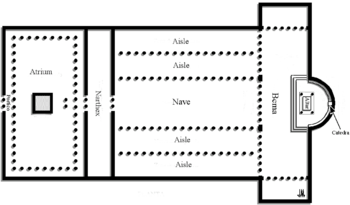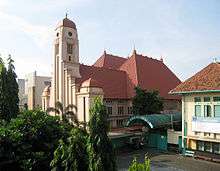Church architecture

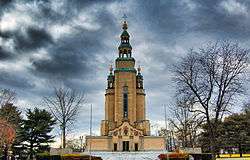
Church architecture refers to the architecture of buildings of Christian churches. It has evolved over the two thousand years of the Christian religion, partly by innovation and partly by imitating other architectural styles as well as responding to changing beliefs, practices and local traditions. From the birth of Christianity to the present, the most significant objects of transformation for Christian architecture and design were the great churches of Byzantium, the Romanesque abbey churches, Gothic cathedrals and Renaissance basilicas with its emphasis on harmony. These large, often ornate and architecturally prestigious buildings were dominant features of the towns and countryside in which they stood. But far more numerous were the parish churches scattered across the Christian world, the focus of Christian devotion in every town and village. While a few are counted as sublime works of architecture to equal the great cathedrals, the majority developed along simpler lines, showing great regional diversity and often demonstrating local vernacular technology and decoration.
Buildings were at first adapted from those originally intended for other purposes but, with the rise of distinctively ecclesiastical architecture, church buildings came to influence secular ones which have often imitated religious architecture. In the 20th century, the use of new materials, such as steel and concrete, has had an effect upon the design of churches. The history of church architecture divides itself into periods, and into countries or regions and by religious affiliation. The matter is complicated by the fact that buildings put up for one purpose may have been re-used for another, that new building techniques may permit changes in style and size, that changes in liturgical practice may result in the alteration of existing buildings and that a building built by one religious group may be used by a successor group with different purposes.
Origins and development of the church building
The simplest church building comprises a single meeting space, built of locally available material and using the same skills of construction as the local domestic buildings. Such churches are generally rectangular, but in African countries where circular dwellings are the norm, vernacular churches may be circular as well. A simple church may be built of mud brick, wattle and daub, split logs or rubble. It may be roofed with thatch, shingles, corrugated iron or banana leaves. However, church congregations, from the 4th century onwards, have sought to construct church buildings that were both permanent and aesthetically pleasing. This had led to a tradition in which congregations and local leaders have invested time, money and personal prestige into the building and decoration of churches.
Within any parish, the local church is often the oldest building, and is larger than any pre-19th-century structure except perhaps a barn. The church is often built of the most durable material available, often dressed stone or brick. The requirements of liturgy have generally demanded that the church should extend beyond a single meeting room to two main spaces, one for the congregation and one in which the priest performs the rituals of the Mass. To the two-room structure is often added aisles, a tower, chapels, and vestries and sometimes transepts and mortuary chapels. The additional chambers may be part of the original plan, but in the case of a great many old churches, the building has been extended piecemeal, its various parts testifying to its long architectural history.
Beginnings

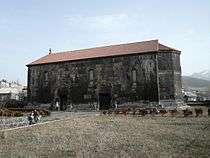
In the first three centuries of the Early Christian Church, the practice of Christianity was illegal and few churches were constructed. In the beginning Christians worshipped along with Jews in synagogues and in private houses. After the separation of Jews and Christians the latter continued to worship in people's houses, known as house churches. These were often the homes of the wealthier members of the faith. St Paul, in his first letter to the Corinthians (chapter 16:19) writes: The assemblies of Asia greet you. Aquila and Priscilla greet you much in the Lord, together with the assembly that is in their house..
Some domestic buildings were adapted to function as churches. One of the earliest of adapted residences is at Dura Europos church, built shortly after 200 AD, where two rooms were made into one, by removing a wall, and a dais was set up. To the right of the entrance a small room was made into a baptistry.
Some church buildings were specifically built as church assemblies, such as that opposite the emperor Diocletian's palace in Nicomedia. Its destruction was recorded thus:
When that day dawned, in the eighth consulship of Diocletian and seventh of Maximian, suddenly, while it was yet hardly light, the prefect, together with chief commanders, tribunes, and officers of the treasury, came to the church in Nicomedia, and the gates having been forced open, they searched everywhere for an idol of the Divinity. The books of the Holy Scriptures were found, and they were committed to the flames; the utensils and furniture of the church were abandoned to pillage: all was rapine, confusion, tumult. That church, situated on rising ground, was within view of the palace; and Diocletian and Galerius stood, as if on a watchtower, disputing long whether it ought to be set on fire. The sentiment of Diocletian prevailed, who dreaded lest, so great a fire being once kindled, some part of the city might he burnt; for there were many and large buildings that surrounded the church. Then the Pretorian Guards came in battle array, with axes and other iron instruments, and having been let loose everywhere, they in a few hours levelled that very lofty edifice with the ground.[1]
From house church to church
From the first to the early fourth centuries most Christian communities worshipped in private homes, often secretly. Some Roman churches, such as the Basilica of San Clemente in Rome, are built directly over the houses where early Christians worshipped. Other early Roman churches are built on the sites of Christian martyrdom or at the entrance to catacombs where Christians were buried.
With the victory of the Roman emperor Constantine at the Battle of Milvian Bridge in 312 AD, Christianity became a lawful and then the privileged religion of the Roman Empire. The faith, already spread around the Mediterranean, now expressed itself in buildings. Christian architecture was made to correspond to civic and imperial forms, and so the Basilica, a large rectangular meeting hall became general in east and west, as the model for churches, with a nave and aisles and sometimes galleries and clerestories. While civic basilicas had apses at either end, the Christian basilica usually had a single apse where the bishop and presbyters sat in a dais behind the altar. While pagan basilicas had as their focus a statue of the emperor, Christian basilicas focused on the Eucharist as the symbol of the eternal, loving and forgiving God.
The first very large Christian churches, notably Santa Maria Maggiore, San Giovanni in Laterano, and Santa Costanza, were built in Rome in the early 4th century.[2]
Characteristics of the Early Christian church building
The church building as we know it grew out of a number of features of the Ancient Roman period:
- The house church
- The atrium
- The basilica
- The bema
- The mausoleum: centrally-planned building
- The cruciform ground plan: Latin or Greek cross
Atrium
When Early Christian communities began to build churches they drew on one particular feature of the houses that preceded them, the atrium, or courtyard with a colonnade surrounding it. Most of these atriums have disappeared. A fine example remains at the Basilica of San Clemente in Rome and another was built in the Romanesque period at Sant'Ambrogio, Milan. The descendants of these atria may be seen in the large square cloisters that can be found beside many cathedrals, and in the huge colonnaded squares or piazze at the Basilicas of St Peter's in Rome and St Mark's in Venice and the Camposanto (Holy Field) at the Cathedral of Pisa.
Basilica
Early church architecture did not draw its form from Roman temples, as the latter did not have large internal spaces where worshipping congregations could meet. It was the Roman basilica, used for meetings, markets and courts of law that provided a model for the large Christian church and that gave its name to the Christian basilica.[3]
Both Roman basilicas and Roman bath houses had at their core a large vaulted building with a high roof, braced on either side by a series of lower chambers or a wide arcaded passage. An important feature of the Roman basilica was that at either end it had a projecting exedra, or apse, a semicircular space roofed with a half-dome. This was where the magistrates sat to hold court. It passed into the church architecture of the Roman world and was adapted in different ways as a feature of cathedral architecture.[2]
The earliest large churches, such as the Cathedral of San Giovanni in Laterano in Rome, consisted of a single-ended basilica with one apsidal end and a courtyard, or atrium, at the other end. As Christian liturgy developed, processions became part of the proceedings. The processional door was that which led from the furthest end of the building, while the door most used by the public might be that central to one side of the building, as in a basilica of law. This is the case in many cathedrals and churches.[4]
Bema
As numbers of clergy increased, the small apse which contained the altar, or table upon which the sacramental bread and wine were offered in the rite of Holy Communion, was not sufficient to accommodate them. A raised dais called a bema formed part of many large basilican churches. In the case of St. Peter's Basilica and San Paolo fuori le Mura (St Paul's outside the Walls) in Rome, this bema extended laterally beyond the main meeting hall, forming two arms so that the building took on the shape of a T with a projecting apse. From this beginning, the plan of the church developed into the so-called Latin Cross which is the shape of most Western Cathedrals and large churches. The arms of the cross are called the transept.[5]

Mausoleum
One of the influences on church architecture was the mausoleum. The mausoleum of a noble Roman was a square or circular domed structure which housed a sarcophagus. The Emperor Constantine built for his daughter Costanza a mausoleum which has a circular central space surrounded by a lower ambulatory or passageway separated by a colonnade. Santa Costanza's burial place became a place of worship as well as a tomb. It is one of the earliest church buildings that was centrally, rather than longitudinally planned. Constantine was also responsible for the building of the circular, mausoleum-like Church of the Holy Sepulchre in Jerusalem, which in turn influenced the plan of a number of buildings, including that constructed in Rome to house the remains of the proto-martyr Stephen, San Stefano Rotondo and the Basilica of San Vitale in Ravenna.
Ancient circular or polygonal churches are comparatively rare. A small number, such as the Temple Church, London were built during the Crusades in imitation of the Church of the Holy Sepulchre as isolated examples in England, France and Spain. In Denmark such churches in the Romanesque style are much more numerous. In parts of Eastern Europe there are also round tower-like churches of the Romanesque period but they are generally vernacular architecture and of small scale. Others, like St Martin's Rotunda at Vishegrad, in the Czech Republic, are finely detailed.
The circular or polygonal form lent itself to those buildings within church complexes that perform a function in which it is desirable for people to stand, or sit around, with a centralised focus, rather than an axial one. In Italy the circular or polygonal form was used throughout the medieval period for baptisteries, while in England it was adapted for chapter houses. In France the aisled polygonal plan was adapted as the eastern terminal and in Spain the same form is often used as a chapel.
Other than Santa Costanza and San Stefano, there was another significant place of worship in Rome that was also circular, the vast Ancient Roman Pantheon, with its numerous statue-filled niches. This too was to become a Christian church and lend its style to the development of Cathedral architecture.
Latin cross and Greek cross
Most cathedrals and great churches have a cruciform groundplan. In churches of Western European tradition, the plan is usually longitudinal, in the form of the so-called Latin Cross with a long nave crossed by a transept. The transept may be as strongly projecting as at York Minster or not project beyond the aisles as at Amiens Cathedral.
Many of the earliest churches of Byzantium have a longitudinal plan. At Hagia Sophia, Istanbul, there is a central dome, frame on one axis by two high semi-domes and on the other by low rectangular transept arms, the overall plan being square. This large church was to influence the building of many later churches, even into the 21st century. A square plan in which the nave, chancel and transept arms are of equal length forming a Greek cross, the crossing generally surmounted by a dome became the common form in the Orthodox Church, with many churches throughout Eastern Europe and Russia being built in this way. Churches of the Greek Cross form often have a narthex or vestibule which stretches across the front of the church. This type of plan was also to later play a part in the development of church architecture in Western Europe, most notably in Bramante's plan for St. Peter's Basilica.[2][5]


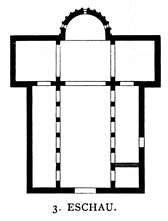
Divergence of Eastern and Western church architecture
The division of the Roman Empire in the fourth century AD, resulted in Christian ritual evolving in distinctly different ways in the eastern and western parts of the empire. The final break was the Great Schism of 1054.
Eastern Orthodoxy and Byzantine Architecture
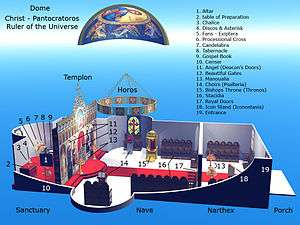
Eastern Christianity and Western Christianity began to diverge from each other from an early date. Whereas the basilica was the most common form in the west, a more compact centralised style became predominant in the east. These churches were in origin martyria, constructed as mausoleums housing the tombs of the saints who had died during the persecutions which only fully ended with the conversion of the Emperor Constantine. An important surviving example is the Mausoleum of Galla Placidia in Ravenna, which has retained its mosaic decorations. Dating from the 5th century, it may have been briefly used as an oratory before it became a mausoleum.
These buildings copied pagan tombs and were square, cruciform with shallow projecting arms or polygonal. They were roofed by domes which came to symbolise heaven. The projecting arms were sometimes roofed with domes or semi-domes that were lower and abutted the central block of the building. Byzantine churches, although centrally planned around a domed space, generally maintained a definite axis towards the apsidal chancel which generally extended further than the other apses. This projection allowed for the erection of an iconostasis, a screen on which icons are hung and which conceals the altar from the worshippers except at those points in the liturgy when its doors are opened.
The architecture of Constantinople (Istanbul) in the 6th century produced churches that effectively combined centralised and basilica plans, having semi-domes forming the axis, and arcaded galleries on either side. The church of Hagia Sophia (now a museum) was the most significant example and had an enormous influence on both later Christian and Islamic architecture, such as the Dome of the Rock in Jerusalem and the Umayyad Great Mosque in Damascus. Many later Eastern Orthodox churches, particularly large ones, combine a centrally planned, domed eastern end with an aisled nave at the west.
A variant form of the centralised church was developed in Russia and came to prominence in the sixteenth century. Here the dome was replaced by a much thinner and taller hipped or conical roof which perhaps originated from the need to prevent snow from remaining on roofs. One of the finest examples of these tented churches is St. Basil's in Red Square in Moscow.
Medieval West


Participation in worship, which gave rise to the porch church, began to decline as the church became increasingly clericalised; with the rise of the monasteries church buildings changed as well. The 'two-room' church' became, in Europe, the norm. The first 'room', the nave, was used by the congregation; the second 'room', the sanctuary, was the preserve of the clergy and was where the Mass was celebrated. This could then only be seen from a distance by the congregation through the arch between the rooms (from late mediaeval times closed by a wooden partition, the Rood screen), and the elevation of the host, the bread of the communion, became the focus of the celebration: it was not at that time generally partaken of by the congregation. Given that the liturgy was said in Latin, the people contented themselves with their own private devotions until this point. Because of the difficulty of sight lines, some churches had holes, 'squints', cut strategically in walls and screens, through which the elevation could be seen from the nave. Again, from the twin principles that every priest must say his mass every day and that an altar could only be used once, in religious communities a number of altars were required for which space had to be found, at least within monastic churches.
Apart from changes in the liturgy, the other major influence on church architecture was in the use of new materials and the development of new techniques. In northern Europe, early churches were often built of wood, for which reason almost none survive. With the wider use of stone by the Benedictine monks, in the tenth and eleventh centuries, larger structures were erected.
The 'two-room' church, particularly if it were an abbey or a cathedral, might acquire transepts, effectively arms of the cross which now made up the groundplan of the building. The buildings became more clearly symbolic of what they were intended for. Sometimes this crossing, now the central focus of the church, would be surmounted by its own tower, in addition to the west end towers, or instead of them. (Such precarious structures were known to collapse - as at Ely - and had to be rebuilt). Sanctuaries, now providing for the singing of the offices by monks or canons, grew longer and became chancels, separated from the nave by a screen. Practical function and symbolism were both at work in the process of development.
Factors affecting the architecture of churches
Across Europe, the process by which church architecture developed and individual churches were designed and built was different in different regions, and sometimes differed from church to church in the same region and within the same historic period.
Among the factors that determined how a church was designed and built are the nature of the local community, the location in city, town or village, whether the church was an abbey church, whether the church was a collegiate church, whether the church had the patronage of a bishop, whether the church had the ongoing patronage of a wealthy family and whether the church contained relics of a saint or other holy objects that were likely to draw pilgrimage.
Collegiate churches and abbey churches, even those serving small religious communities, generally demonstrate a greater complexity of form than parochial churches in the same area and of a similar date.
Churches that have been built under the patronage of a bishop have generally employed a competent church architect and demonstrate in the design a refinement of style unlike that of the parochial builder.
Many parochial churches have had the patronage of wealthy local families. The degree to which this has affect on the architecture can differ greatly. It may entail the design and construction of the entire building having been financed and influenced by a particular patron. On the other hand, the evidence of patronage may be apparent only in an accretion of chantry chapels, tombs, memorials, fittings, stained glass and other decorations.
Churches that contain famous relics or objects of veneration and have thus become pilgrimage churches are often very large and have been elevated to the status of basilica. However, many other churches enshrine the bodies or are associated with the lives of particular saints without having attracted continuing pilgrimage and the financial benefit that it brought.
The popularity of saints, the veneration of their relics, and the size and importance of the church built to honour them are without consistency and can be dependent upon entirely different factors. Two virtually unknown warrior saints, San Giovanni and San Paolo, are honoured by one of the largest churches in Venice, built by the Dominican Friars in competition to the Franciscans who were building the Frari Church at the same time. The much smaller church that contained the body of Saint Lucy, a martyr venerated by Catholics and Protestants across the world and the titular saint of numerous locations, was demolished in the late 19th century to make way for Venice’s railway station.
After the second world war, modern materials and techniques such as concrete and metal panels were introduced in Norwegian church construction. Bodø Cathedral for instance was built in reinforced concrete allowing a wide basilica to be built. During the 1960s there was a more pronounced break from tradition as in the Arctic Cathedral built in lightweight concrete and covered in aluminum sidings.
Wooden churches
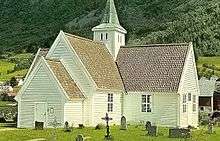
In Norway, church architecture has been affected by wood as the preferred material, particularly in sparsely populated areas. Churches built until the second world war are about 90% wooden except medieval constructions.[6] During the Middle Ages all wooden churches in Norway (about 1000 in total) were constructed in the stave church technique, but only 271 masonry constructions.[7] After the Protestant reformation when the construction of new (or replacement of old) churches was resumed, wood was still the dominant material but the log technique became dominant.[8] The log construction gave a lower more sturdy style of building compared to the light and often tall stave churches. Log construction became structurally unstable for long and tall walls, particularly if cut through by tall windows. Adding transepts improved the stability of the log technique and is one reason why the cruciform floor plan was widely used during 1600 and 1700s. For instance the Old Olden Church (1759) replaced a building damaged by hurricane, the 1759 church was then constructed in cruciform shape to make it withstand the strongest winds.[9] The length of trees (logs) also determined the length of walls according to Sæther.[10] In Samnanger church for instance, outside corners have been cut to avoid splicing logs, the result is an octagonal floor plan rather than rectangular.[11] The cruciform constructions provided a more rigid structure and larger churches, but view to the pulpit and altar was obstructed by interior corners for seats in the transept. The octagonal floor plan offers good visibility as well as a rigid structure allowing a relatively wide nave to be constructed - Håkon Christie believes that this is a reason why the octagonal church design became popular during the 1700s.[8] Vreim believes that the introduction of log technique after the reformation resulted in a multitude of church designs in Norway.[12]
In Ukraine, wood church constructions originate from the introduction of Christianity and continued to be widespread, particularly in rural areas, when masonry churches dominated in cities and in Western Europe.
Ethiopian church architecture

Although having its roots in the traditions of Eastern Christianity – especially the Syrian church – as well as later being exposed to European influences – the traditional style of Ethiopian Orthodox churches has followed a path all its own. The earliest known churches show the familiar basilican layout. For example, the church of Debre Damo is organized around a nave of four bays separated by re-used monolithic columns; at the western end is a low-roofed narthex, while on the eastern is the maqdas, or Holy of Holies, separated by the only arch in the building.[13]
The next period, beginning in the second half of the first millennium AD and lasting into the 16th century, includes both structures built of conventional materials, and those hewn from rock. Although most surviving examples of the first are now found in caves, Thomas Pakenham discovered an example in Wollo, protected inside the circular walls of later construction.[14] An example of these built-up churches would be the church of Yemrehana Krestos, which has many resemblances to the church of Debre Damo both in plan and construction.[15]
The other style of this period, perhaps the most famous architectural tradition of Ethiopia, are the numerous monolithic churches. This includes houses of worship carved out of the side of mountains, such as Abreha we Atsbeha, which although approximately square the nave and transepts combine to form a cruciform outline – leading experts to categorize Abreha we Atsbeha as an example of cross-in-square churches. Then there are the churches of Lalibela, which were created by excavating into "a hillside of soft, reddish tuff, variable in hardness and composition". Some of the churches, such as Bete Ammanuel and the cross-shaped Bete Giyorgis, are entirely free-standing with the volcanic tuff removed from all sides, while other churches, such as Bete Gabriel-Rufael and Bete Abba Libanos, are only detached from the living rock on one or two sides. All of the churches are accessed through a labyrinth of tunnels.[16]
The final period of Ethiopian church architecture, which extends to the present day, is characterized by round churches with conical roofs – quite similar to the ordinary houses the inhabitants of the Ethiopian highlands live in. Despite this resemblance, the interiors are quite different in how their rooms are laid out, based on a three-part division of: (1) a maqdas where the tabot is kept, and only priests may enter; (2) an inner ambulatory called the qiddist used by communicants at mass; and (3) an outer ambulatory, the qene mehlet, used by the dabtaras and accessible to anyone.[17]
The Reformation and its influence on church architecture
In the early 16th century Martin Luther and the Reformation brought a period of radical change to church design. According to the ideals of the Protestant reformation, the spoken word, the sermon, should be central act in the church service. This implied that the pulpit became the focal point of the church interior and that churches should be designed to allow all to hear and see the minister.[18] Pulpits had always been a feature of Western churches. The birth of Protestantism led to extensive changes in the way that Christianity was practiced (and hence the design of churches).
During the Reformation period, there was an emphasis on "full and active participation". The focus of Protestant churches was on the preaching of the Word, rather than a sacerdotal emphasis. Holy Communion tables became wood to emphasize that Christ's sacrifice was made once for all and were made more immediate to the congregation to emphasize man's direct access to God through Christ.
In the Netherlands the Reformed church in Willemstad, North Brabant, Koepelkerk (Domed Church) (1607), the first Protestant church building in the Netherlands, was given an octagonal shape according to Calvinism's focus on the sermon.[19]
In Britain during the seventeenth and eighteenth centuries, it became usual for Anglican churches to display the Royal Arms inside, either as a painting or as a relief, to symbolise the monarch's role as head of the church.[20]
Modernism
The idea that worship was a corporate activity and that the congregation should be in no way excluded from sight or participation derives from the Liturgical Movement. Simple one-room plans are almost of the essence of modernity in architecture. In France and Germany between the first and second World Wars, some of the major developments took place. The church at Le Raincy near Paris by Auguste Perret is cited as the starting point of process, not only for its plan but also for the materials used, reinforced concrete. More central to the development of the process was Schloss Rothenfels-am-Main in Germany which was remodelled in 1928. Rudolf Schwartz, its architect, was hugely influential on later church building, not only on the continent of Europe but also in the United States of America. Schloss Rothenfels was a large rectangular space, with solid white walls, deep windows and a stone pavement. It had no decoration. The only furniture consisted of a hundred little black cuboid moveable stools. For worship, an altar was set up and the faithful surrounded it on three sides.
Corpus Christi in Aachen was Schwartz's first parish church and adheres to the same principles, very much reminiscent of the Bauhaus movement of art. Externally it is a plan cube; the interior has white walls and colourless windows, a langbau i.e. a narrow rectangle at the end of which is the altar. It was to be, said Schwartz not 'christocentric' but 'theocentric'. In front of the altar were simple benches. Behind the altar was a great white void of a back wall, signifying the region of the invisible Father. The influence of this simplicity spread to Switzerland with such architects as Fritz Metzger and Dominikus Böhm.
After the Second World War, Metzger continued to develop his ideas, notably with the church of St. Franscus at Basel-Richen. Another notable building is Notre Dame du Haut at Ronchamp by Le Corbusier (1954). Similar principles of simplicity and continuity of style throughout can be found in the United States, in particular at the Roman Catholic Abbey church of St. Procopius, in Lisle, near Chicago (1971).
A theological principle which resulted in change was the decree Sacrosanctum Concilium of the Second Vatican Council issued in December 1963. This encouraged 'active participation' (in Latin: participatio actuosa) by the faithful in the celebration of the liturgy by the people and required that new churches should be built with this in mind (para 124) Subsequently, rubrics and instructions encouraged the use of a freestanding altar allowing the priest to face the people. The effect of these changes can be seen in such churches as the Roman Catholic Metropolitan Cathedrals of Liverpool and the Brasília, both circular buildings with a free-standing altar.
Different principles and practical pressures produced other changes. Parish churches were inevitably built more modestly. Often shortage of finances, as well as a 'market place' theology suggested the building of multi-purpose churches, in which secular and sacred events might take place in the same space at different times. Again, the emphasis on the unity of the liturgical action, was countered by a return to the idea of movement. Three spaces, one for the baptism, one for the liturgy of the word and one for the celebration of the eucharist with a congregation standing around an altar, were promoted by Richard Giles in England and the United States. The congregation were to process from one place to another. Such arrangements were less appropriate for large congregations than for small; for the former, proscenium arch arrangements with huge amphitheatres such as at Willow Creek Community Church in Chicago in the United States have been one answer.
Postmodernism
As with other Postmodern movements, the Postmodern movement in architecture formed in reaction to the ideals of modernism as a response to the perceived blandness, hostility, and utopianism of the Modern movement. While rare in designs of church architecture, there are nonetheless some notable examples as architects have begun to recover and renew historical styles and "cultural memory" of Christian architecture. Notable practitioners include Dr. Steven Schloeder, Duncan Stroik, and Thomas Gordon Smith.
The functional and formalized shapes and spaces of the modernist movement are replaced by unapologetically diverse aesthetics: styles collide, form is adopted for its own sake, and new ways of viewing familiar styles and space abound. Perhaps most obviously, architects rediscovered the expressive and symbolic value of architectural elements and forms that had evolved through centuries of building—often maintaining meaning in literature, poetry and art—but which had been abandoned by the modern movement.
Examples
-

Jaszczurówka Chapel, Podhale, Poland, in Zakopane Style
-
Kizhi Pogost, Kizhi island, Lake Onega, Russia
-
Original building of Roswell Presbyterian Church, Roswell, Georgia, USA
-
Wooroolin Church, Queensland, Australia
-

Resiutta, Italy
-
Margarita, Cuneo, Italy
-

St Gregory the Great, Kirknewton, Scotland
-

Collegiate Church of St Vitus
-

Sant'Agostino, San Gimignano, Tuscany
-

San Bartolo, San Gimignano
-

Rococo choir of Church of Saint-Sulpice, Fougères, Brittany, 16th – 18th century
-
-Nef.jpg)
Saint John the Baptist of Saint-Jean-de-Luz, France
-

Santa María, Cambre, Galicia, Spain
-

San Pedro de Dozón, Spain
-

Romanesque interior, Schöngrabern, Austria
-

St Bartholomew-the-Great, London
-

St Martin's in the Fields, London
-
Presbyterian church, Washington, Georgia, 1826
-

Katowice, Poland
-
Katowice, Poland
-

Queensland Carpenter Gothic
-
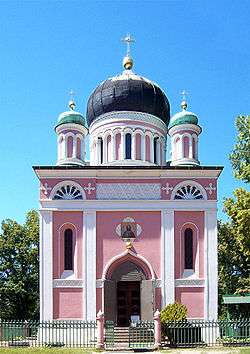
Alexander Nevsky church in Potsdam, the oldest example of Russian Revival architecture
-

Road church in Baden-Baden, Germany
-
.jpg)
Interior of a Medieval Welsh church c.1910
See also
- Akron plan
- Bell-gable
- Churches of Kraków
- Marian and Holy Trinity columns
- Mathematics and architecture
- Monastery
- Oldest churches in the world
- Polish Cathedral style churches in North America
- Religious architecture
- Tin tabernacle
- Category:Church architecture
References
- Bibliography
- Bühren, Ralf van: Kunst und Kirche im 20. Jahrhundert. Die Rezeption des Zweiten Vatikanischen Konzils, Paderborn: Ferdinand Schöningh 2008 (ISBN 978-3-506-76388-4)
- Bony, J: The English Decorated Style Phaidon, Oxford 1979
- Davies, J. G.: Dictionary of Liturgy and Worship, London: SCM 1971
- Giles, Richard: Repitching the Tent, Norwich: Canterbury Press 1996
- Giles, Richard: Uncommon Worship, Norwich: Canterbury Press 2004
- Graham-Dixon, Andrew: A History of British Art Chapter 1, London: BBC Books 1996
- Harvey, John: The Mediaeval Architect, London: Wayland 1972
- Howard F.E. The mediaeval styles of the English Parish Church Batsford London 1937
- Menachery, George,Ed. The St. Thomas Christian Encyclopaedia of India" 3.vols. For hundreds pf photographs on Indian Church Architecture. Trichur 1973, Trichur 1982, Ollur 2009
- Menachery, George,Ed., "Indian Church History Classics", Vol. I The Nazranies (500 Photos), SARAS, Ollur 1998
- Pevsner, Nikolaus: The Buildings of England (series), Harmondsworth: Penguin 1951-1974
- Sovik, Edward A. (1973). Architecture for worship. Minneapolis, Minnesota: Augsburg Publishing House. ISBN 0-8066-1320-3. Focusing on modern church architecture, mid-20th-century.
- Schloeder, Steven J.: Architecture in Communion, San Francisco: Ignatius Press 1998
- "Ecclesiastical Architecture". Catholic Encyclopedia. Retrieved 18 February 2007.
- Notes
- ↑ Lactantius, Mort Pers, 12; Ante-Nicene Fathers, Vol. 7.
- 1 2 3 Andre Grabar, The Beginnings of Christian Art.
- ↑ Ward-Perkins, J. B. (1994). Studies in Roman and Early Christian Architecture. London: The Pindar Press. pp. 455–456.
- ↑ Beny and Gunn, Churches of Rome.
- 1 2 Fletcher, Banister. A History of Architecture
- ↑ Muri, Sigurd (1975): Gamle kyrkjer i ny tid. Oslo: Samlaget.
- ↑ Dietrichson, Lorentz (1892):De norske stavkirker. Studier over deres system, oprindelse og historiske udvikling. Kristiania: Cammermeyer, s.35.
- 1 2 Christie, Håkon (1991): Kirkebygging i Norge i 1600- og 1700-årene. Årbok for Fortidsminneforeningen, årgang 145, s. 177-194.
- ↑ County archives about Olden Church article published 2000, accessed online September 14, 2013.
- ↑ Sæther, Arne E. (1990): Kirken som bygg og bilde. Rom og liturgi mot et tusenårsskifte. Arne E. Sæther i samarbeid med Kirkerådet og Kirkekonsulenten.
- ↑ Norges Kirker (Churches in Norway) accessed September 14, 2013.
- ↑ Vreim, Halvor (1947): Norsk trearkitektur. Oslo: Gyldendal.
- ↑ David Buxton, The Abyssinians (New York:Praeger, 1970), pp. 97-99
- ↑ Pakenham, The Mountains of Rasselas (London: Reynal and Co., 1959), pp. 124-137
- ↑ Further details in David W. Phillipson, Ancient Churches of Ethiopia (New Haven: Yale University Press, 2009), pp. 75ff
- ↑ For a detailed description of the Lalibela churches, see Phillipson, Ancient Churches, pp. 123-181
- ↑ Buxton, The Abyssinians, pp. 116-118
- ↑ Hosar, Kåre (1988): Sør-Fron kirke. Lokal bakgrunn og impulser utenfra. Magisteravhandling i kunsthistorie (dissertation, history of art). Universitetet i Oslo.
- ↑ Kleinbauer, W. Eugene (1988): Modern perspectives in Western art history. An anthology of twentieth-century writings on the visual arts. Toronto : Published by University of Toronto Press in association with the Medieval Academy of America, s.318.
- ↑ "Royal Arms in church". Intriguing History. Retrieved 19 November 2015.
External links
- Oldest Christian chapel in the Holy Land found
- EnVisionChurch.org, Commentaries and case studies on modern church building and architecture
- Photographs of European cathedrals, monasteries and cloisters
- Digital collection with floor plans, details, sections, and elevations of three Buffalo churches from the University at Buffalo Libraries
